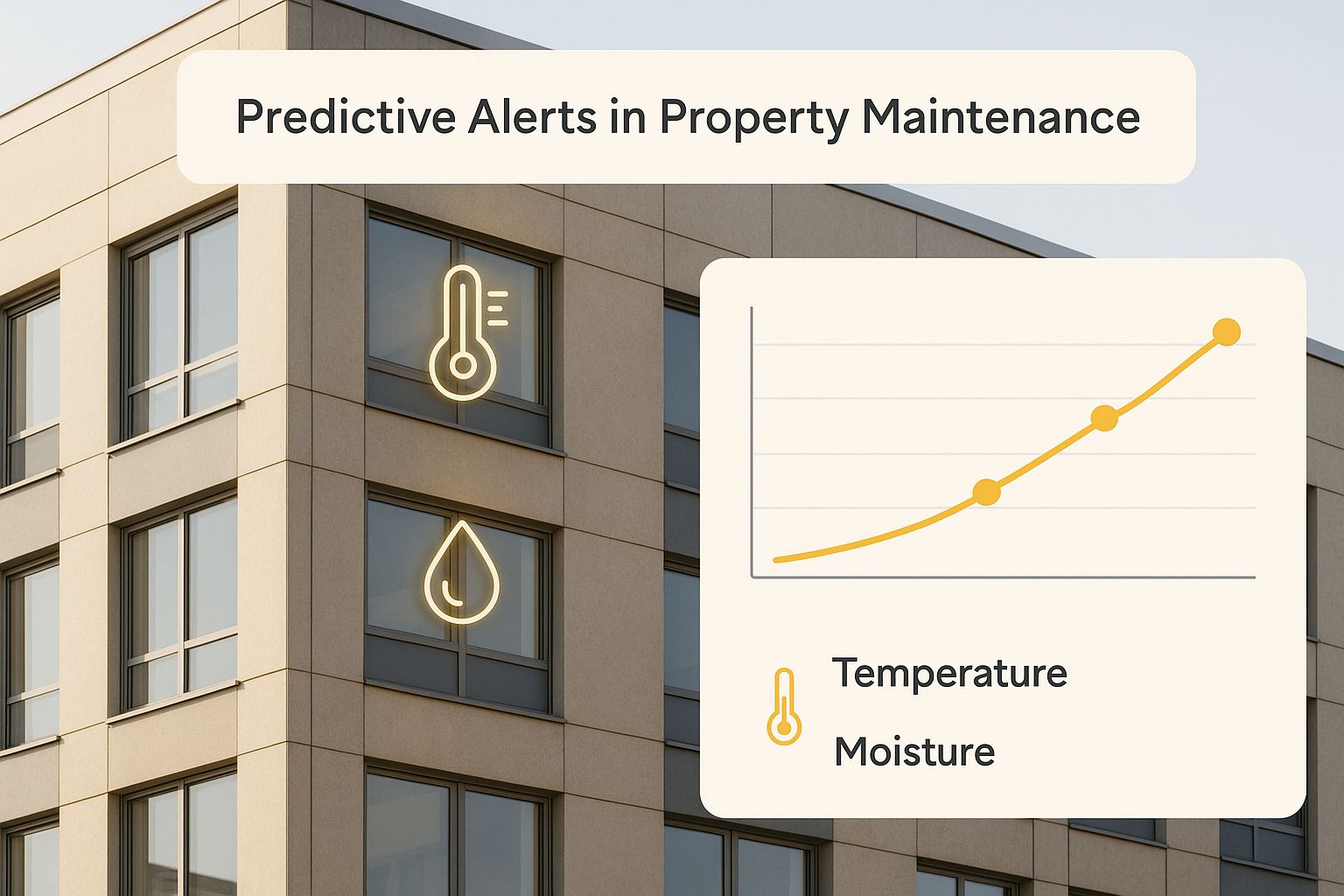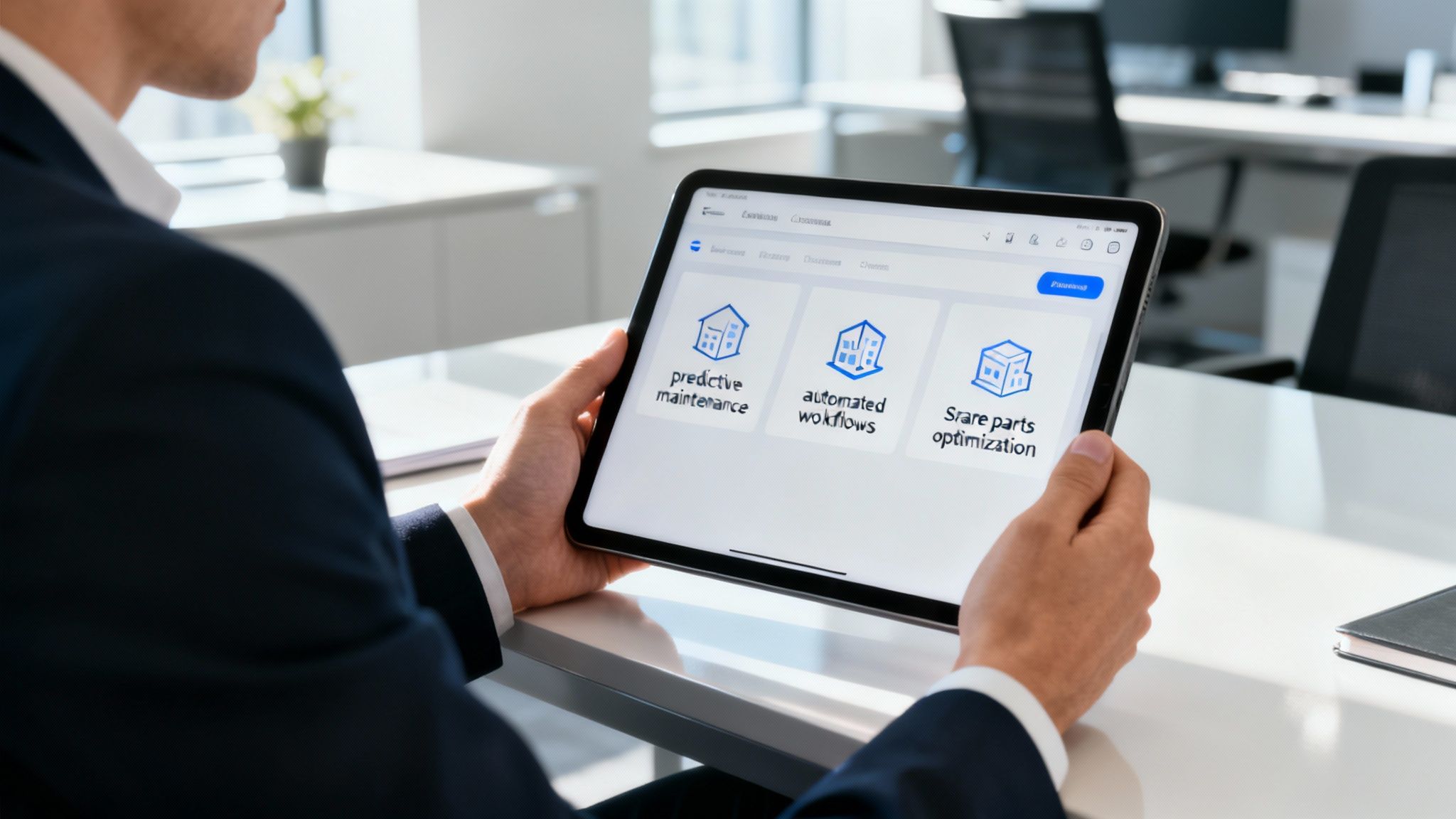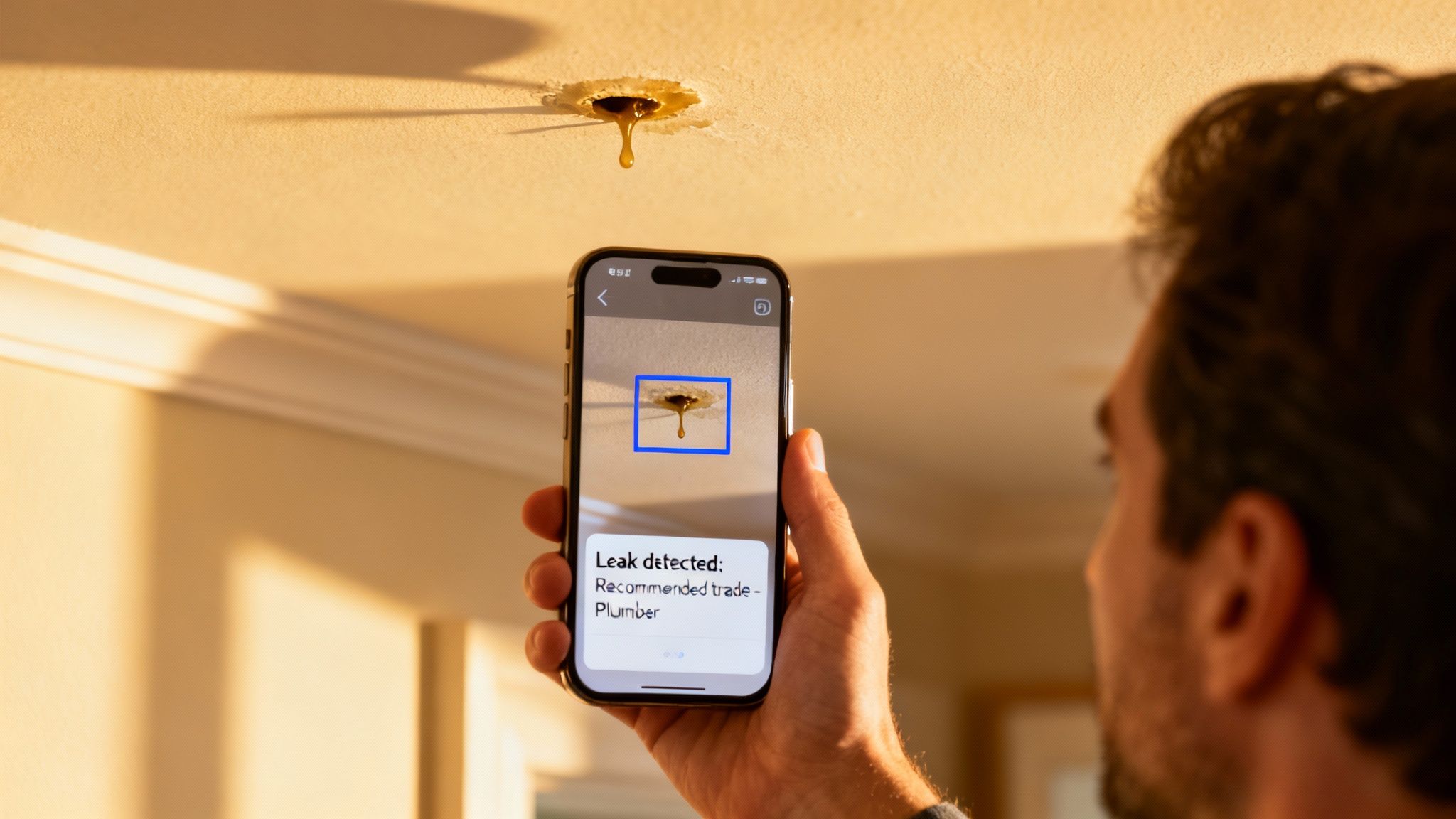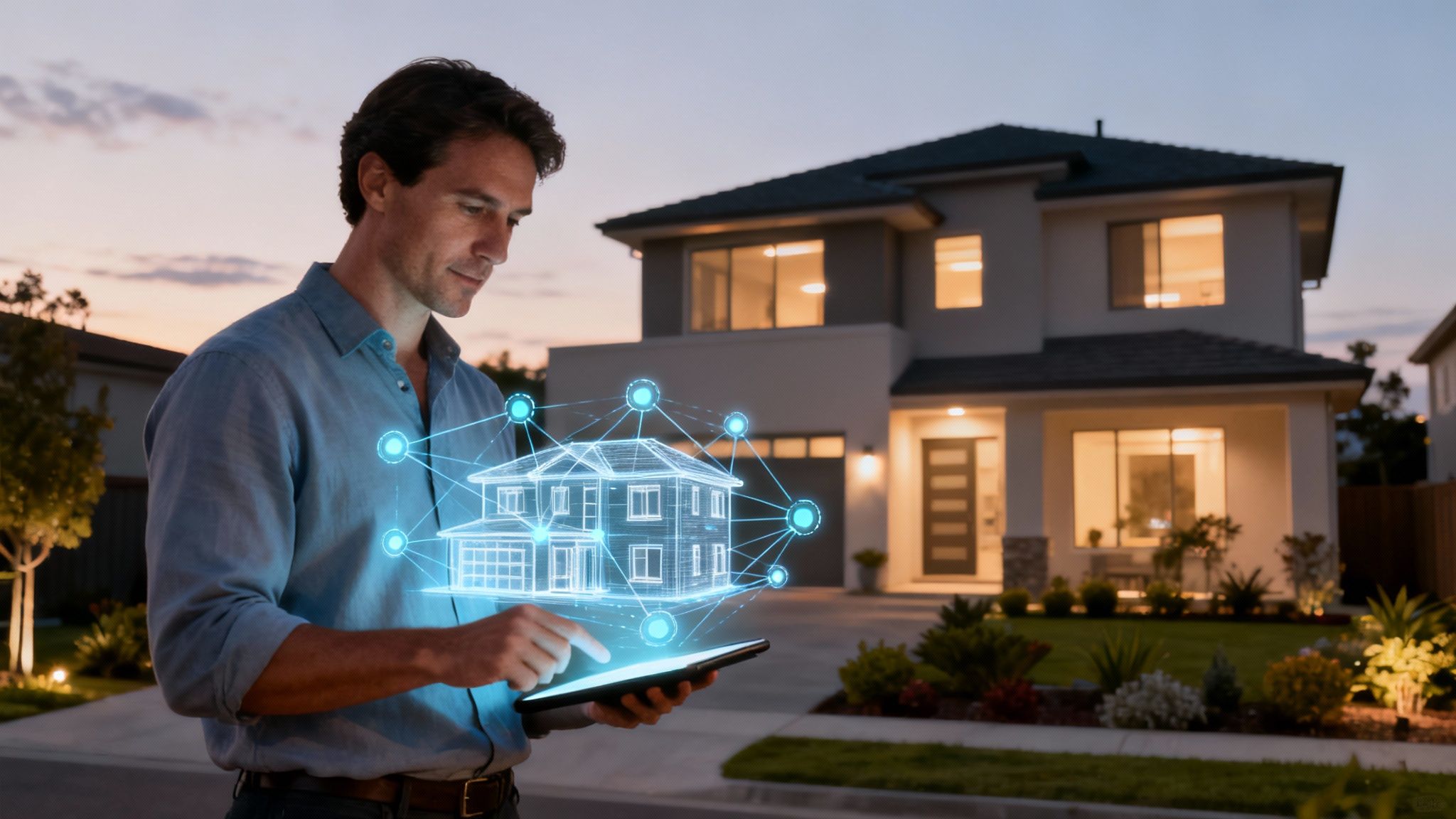Picture this: your property sends you a heads-up about a problem before it actually happens. That’s the real magic behind AI property maintenance. It’s a system designed to shift management away from frantic, last-minute fixes and towards preventing issues in the first place. Think of it as a smart health monitor for your building, constantly checking its vital signs to catch small problems before they snowball into expensive disasters.
Why AI Is Reinventing Property Maintenance
Let’s be honest, traditional property management is often just a cycle of putting out fires. A tenant calls about a leak, you scramble to find a plumber, and the costs just keep climbing. It's an inefficient, stressful, and costly way to operate. AI property maintenance completely flips this model on its head by bringing a proactive, data-driven approach to the table.
Instead of waiting for something to break, AI uses a network of sensors and clever algorithms to monitor a building’s health in real-time. It’s like moving from stressful emergency room visits to regular, preventative health check-ups for your property. This isn't just a minor tweak; it's a fundamental reinvention of how we handle upkeep.
The Shift from Reactive to Predictive Upkeep
The big idea driving this change is predictive maintenance. It’s a strategy where AI crunches data from all sorts of sources to forecast when a piece of equipment—like an HVAC unit or a water heater—is about to give up the ghost.
This is all made possible by the Internet of Things (IoT), where small, connected sensors are attached to critical equipment. These tiny gadgets are constantly tracking subtle changes that a person would never notice.
- Vibration Analysis: A sensor on an air conditioning unit can pick up on tiny, abnormal vibrations that signal a worn-out bearing, often weeks before the unit actually fails.
- Temperature Monitoring: If a boiler's operating temperature starts creeping up, it could point to a blockage or inefficiency, letting you schedule a service call well before a winter breakdown.
- Moisture Detection: Smart sensors tucked away in flood-prone spots like basements or under sinks can fire off an instant alert at the first hint of moisture, stopping catastrophic water damage in its tracks.
This infographic shows you exactly how these smart sensors create a protective digital layer over a physical property, giving you the power of predictive alerts.

As the image shows, by keeping an eye on key environmental data, property managers get the foresight they need to act before small issues become major headaches.
Automating the Entire Workflow
But it doesn't stop at just predicting failures. AI also automates the entire response that follows. When a sensor flags an issue, the system doesn't just ping you with an alert; it kicks off a complete workflow. An AI can analyse the fault, automatically generate a work order with all the necessary details, and even dispatch the right contractor from your list of approved tradies. This slashes the administrative workload and guarantees a super-fast response.
AI doesn’t just tell you a problem is coming; it starts the process of fixing it for you. It turns complex coordination into a seamless, automated action, freeing up managers to focus on high-value tasks.
This level of automation can even handle communications. For instance, some platforms can be linked up with an AI answering service to manage tenant calls, gather all the critical info about a maintenance request, and log the details without anyone lifting a finger.
To really get why this is such a game-changer, you have to look at the bigger picture. Broader tech trends, like the integration of AI into drone technology for things like roof and facade inspections, are already here. This isn't some far-off concept; it's a practical set of tools building a smarter, more efficient foundation for property management today.
How AI Is Actually Changing Day-to-Day Property Upkeep
So, we've talked about the big picture, but let's get down to the nitty-gritty. How does AI property maintenance work on the ground? It’s about shifting daily operations from a constant firefight to a calm, well-oiled machine. This all hinges on three core ideas that directly tackle the biggest headaches for Aussie property managers.
The first, and arguably the most powerful, is predictive maintenance. Picture your building’s essential systems—like HVAC, plumbing, and electricals—kitted out with small, smart sensors. These little gadgets get to know the normal operating patterns of the equipment, figuring out what "healthy" looks like.
When a sensor spots a tiny change, like a weird vibration in an air conditioning unit or a slight temperature dip in a boiler, it raises a flag straight away. This isn't a failure alert; it's a pre-failure warning. It gives you the chance to schedule a repair on your own terms, stopping a small hiccup from snowballing into a costly emergency. A perfect real-world example is AI-driven predictive maintenance with automated sensor data processing, which shows just how this tech gets ahead of problems before they even start.

From Manual Grind to Automated Workflows
Next up is automated workflows. Traditionally, when a tenant reports an issue, it kicks off a long, manual chain of events. You have to take the call or read the email, figure out how urgent it is, find the right tradie, and then try to line up everyone's schedules. It’s a grind.
AI takes this entire sequence and puts it on autopilot. When a maintenance request lands, an AI system can instantly scan the text (and even photos) to understand the problem, decide its priority level, and create a detailed work order.
From there, the system automatically finds and assigns the job to the best contractor based on their skills, availability, and location. This means a non-urgent leaky tap gets logged for standard hours, while a burst pipe is immediately escalated to an emergency plumber—all without you lifting a finger. This shift slashes administrative overhead and seriously speeds up response times, which is a massive win for tenant satisfaction.
Making Smarter Use of Your Resources
The third pillar is all about resource optimisation. Let's be honest, managing maintenance isn't just about fixing things as they break; it's about having the right parts, people, and budget ready to go. AI is brilliant at digging into historical data to make smart forecasts.
By looking at past repair records, an AI can predict which spare parts you’ll most likely need for your properties. This lets you buy them in bulk, lock in better prices, and make sure they’re sitting on the shelf when you need them. This simple change cuts down on delays and minimises those painful vacancy periods caused by waiting for a part to arrive.
AI flips your maintenance history on its head. It’s no longer just a record of past expenses—it becomes a powerful predictive tool that actively cuts future costs and keeps you one step ahead.
The move to AI is clearly reshaping how Aussie property managers handle their day-to-day. In fact, the local predictive maintenance market was valued at USD 226.7 million in 2023 and is tipped to hit USD 1,615.3 million by 2030. That growth speaks volumes about how powerful AI is for making property upkeep more efficient and budget-friendly.
All three pillars—predictive maintenance, automated workflows, and resource optimisation—work together to create a system that isn't just more efficient but fundamentally smarter. It turns everyday upkeep from a reactive burden into a genuine strategic advantage.
Here are the real-world perks for Australian landlords.
Let's be honest, jumping on new technology can feel like a bit of a punt. But when it comes to AI property maintenance, the pay-off is clear, measurable, and hits your bottom line directly. This isn't some far-off, futuristic idea; it's about solving the very real, day-to-day headaches Aussie landlords deal with.
Essentially, this tech delivers genuine value in four key ways, all grounded in the realities of our local property market. We're talking about everything from dodging massive, unexpected repair bills to actually boosting the long-term value of your property. It's simply a smarter way to handle your investments.
Drive Big-Time Cost Savings
The first and most obvious win is a massive drop in what you spend on maintenance. The old way of managing property is often a costly waiting game. A small issue pops up, goes unnoticed, and quietly snowballs into a financial nightmare. AI completely flips that around by flagging problems when they’re still small, simple, and cheap to sort out.
Think about a classic scenario: a hot water system starts showing tiny signs it's on the way out. An AI-powered sensor could pick up a slight drop in pressure or a weird temperature fluctuation long before you’d ever see a leak.
- The Proactive Fix: The system flags the issue and automatically gets a technician out for a look. The cost? Maybe $200 for a minor part replacement.
- The Reactive Disaster: Without AI, the first you know about it is a full-blown failure. Now you've got a flooded laundry, ruined flooring, and an emergency replacement bill that could easily top $3,000.
This forward-thinking approach turns expensive emergencies into predictable, budgeted repairs, saving you a fortune while protecting your property from damage.
Boost Tenant Satisfaction and Retention
Good tenants are the lifeblood of any successful rental property, and nothing makes them unhappy faster than slow responses to maintenance requests. It's one of the main reasons tenants decide not to renew their lease. AI tackles this problem head-on by creating a super-efficient communication line.
When a tenant lodges an issue, an AI system can instantly figure out what’s wrong, how urgent it is, and get the right tradie on the job without any delay. That means a tenant with a broken air conditioner in the middle of summer isn't left sweating it out for days waiting for someone to call back.
Fast, efficient, and clear maintenance isn't just a nice-to-have—it's a massive part of the tenant experience. AI-driven systems make your tenants feel heard and looked after, which is a powerful reason for them to stick around.
Better service like this leads directly to fewer vacancies and a much stronger reputation in a crowded rental market.
Make Your Operations More Efficient
As a landlord, your time is your most precious resource. All the admin that comes with maintenance—taking calls, coordinating tradies, chasing up invoices—can be a real drain. That's time you could be spending looking for your next investment or fine-tuning your portfolio strategy.
AI property maintenance automates these repetitive, soul-crushing tasks. It gets you off the operational hamster wheel so you can focus on the stuff that actually grows your wealth. It's a key part of smart property management efficiency and asset growth.
Increase Your Long-Term Asset Value
At the end of the day, looking after your property is the best way to protect and grow its value. Consistent, smart maintenance stops the slow wear and tear that can eat away at what your asset is worth over time. A property that’s been properly maintained doesn’t just pull in better rent; it also fetches a higher price when it’s time to sell.
By keeping a perfect digital log of every single repair and service, AI systems build a complete history for your property. This is rock-solid proof for potential buyers and valuers that you’ve managed the place to the highest standard, making it a much more appealing long-term investment.
Putting AI Property Maintenance Into Practice
Understanding the theory is one thing, but seeing how AI property maintenance actually performs in the real world is where you really see its value. This isn't some far-off future concept; the tech is already being used to solve everyday headaches, turning chaotic, reactive situations into smooth, automated workflows. Let's look at a few practical ways you can put it to work right now.
Think of it this way: AI acts like a smart assistant, doing the initial heavy lifting so property managers can focus on making the final, critical decisions. It’s all about enhancing human judgement, not replacing it.

Intelligent Visual Inspections
One of the most powerful applications is AI-powered visual analysis. Picture this: a tenant notices a small leak under their sink. Instead of fumbling to describe it over the phone or in an email, they just snap a photo and upload it through a tenant portal.
The AI system gets to work instantly, analysing the image. In seconds, it can identify the type of leak, get a rough idea of its severity, and even pinpoint the likely source. Based on that analysis, it suggests the right trade to call—a plumber for a pipe issue or a general handyperson for a simple seal replacement. This cuts out the guesswork and stops you from sending the wrong person to the job, saving a heap of time and money.
24/7 Automated Tenant Triage
Tenant requests don’t conveniently stick to a 9-to-5 schedule. AI chatbots and automated response systems can be your frontline support, ready to handle initial maintenance queries around the clock.
When a tenant submits a request, the AI chatbot kicks off a quick, structured conversation. It asks all the crucial questions a human would:
- "What's the problem?"
- "Which room is it in?"
- "Is there any immediate danger, like a major water leak or an electrical fault?"
- "Can you send a photo or video?"
By the time the request lands in your inbox, it's already been triaged. The AI has gathered the details, prioritised the task based on urgency, and created a neat, actionable ticket. This means a manager starts with a complete picture, ready to assign the job instead of getting bogged down in back-and-forth emails.
AI triage doesn’t just log requests; it organises them. It transforms a flood of tenant emails and calls into a structured, prioritised list, ensuring the most critical issues always get attention first.
Proactive Energy Consumption Monitoring
Here’s another practical use: keeping an eye on a building's utility consumption. An AI system can track real-time energy and water usage from smart meters, figuring out what's "normal" for the property.
If a faulty appliance—like a toilet cistern that won't stop running or an old, inefficient freezer—starts quietly driving up the bills, the AI will spot the anomaly. It flags the unusual consumption pattern and alerts you to check it out. This lets you find and fix hidden resource drains that might otherwise go unnoticed until a shockingly high utility bill arrives, protecting both your bottom line and your tenant's wallet.
Automated After-Hours Emergency Dispatch
Emergency calls are one of the biggest stressors for any property manager. A burst pipe or a failed heating system in the middle of the night needs immediate action, but trying to coordinate it manually can be a nightmare.
AI-powered call management systems can take care of these situations automatically. When an emergency call comes in after hours, the system assesses the urgency based on keywords and the caller's answers. If it’s a genuine crisis, it can instantly access a pre-approved list of emergency contractors and dispatch the right help without anyone needing to lift a finger. This seriously cuts down response times, minimises property damage, and takes a huge weight off managers' shoulders, ensuring properties and tenants are protected 24/7.
Your Step-by-Step Plan to Implement AI
Jumping into AI property maintenance doesn't mean you have to tear down your current systems and start over. A smart transition is all about a steady, phased approach, not some big, disruptive overhaul. Think of it less like building a new house and more like a strategic renovation—you start with the room that needs the most attention first.
This practical roadmap is designed to build your confidence and deliver some early wins, bringing your operations up to speed without causing chaos. It's a manageable plan to make sure you, your team, and your tenants all get something good out of the change.
Start by Identifying Your Biggest Headaches
Before you even glance at a piece of software, grab a pen and paper. What are your biggest operational headaches? Where is your time and money really going? What are the tasks that just drive you up the wall?
Maybe you're drowning in after-hours emergency calls, or perhaps chasing up simple maintenance requests is eating up your entire schedule. Nailing down these specific challenges is the most important first step. This isn't about finding a one-size-fits-all solution; it's about finding the right tool for your most pressing problem.
Launch a Small, Focused Pilot Project
Once you’ve got your biggest headache in your sights, start small. Don't go trying to roll out a portfolio-wide sensor network on day one. Instead, pick a single, low-risk pilot project that directly tackles the problem you’ve identified.
This focused approach lets you test the technology in a controlled way. You can learn how it works and measure the results without a massive upfront investment.
- If tenant communication is a drain: Try an AI-powered chatbot or an automated call management system to handle the first wave of maintenance requests.
- If scheduling is chaotic: Test a basic AI tool that helps sort and assign work orders to the right contractors.
- If you're worried about a specific asset: Install predictive maintenance sensors on a single, high-value HVAC unit in one of your properties to see how it goes.
A pilot project is your sandbox. It’s where you can play around, make mistakes on a small scale, and prove the value of AI before you commit to a bigger rollout.
Find the Right Technology Partner
The AI market is a crowded space, and let's be honest, not all solutions are created equal. When you're choosing a technology partner, don't just look at a list of features—focus on their support and how well they understand the property management game. Your ideal partner should feel more like a guide than just a salesperson.
A great tech partner doesn't just sell you software; they invest in your success. Look for vendors who offer excellent training, responsive customer support, and a clear implementation plan tailored to your business.
They should be able to walk you through how their tool will fit in with your existing systems and help get your team comfortable with the new way of doing things. For anyone looking to get a handle on tenant communication and scheduling, exploring options for real estate workflow automation can be a solid place to start.
Integrate and Train Your Team
The best AI tool in the world is completely useless if your team doesn't know how to use it—or worse, doesn't want to. Bringing your team into the process early on is absolutely critical. You need to explain the "why" behind the change, showing them how it's going to make their jobs easier, not replace them.
Provide solid training and create simple guides they can look back on. Point out how the new system will free them from boring admin tasks, giving them more time to focus on higher-value work like building tenant relationships and strategic planning. A well-supported team is far more likely to get on board and help make it all a success.
This people-first approach is key, especially as the Australian real estate sector continues to embrace new tech. New research shows that 94% of Australian organisations plan to increase AI investment over the next five years, pointing to a major shift towards creating more efficient and sustainable properties. You can read more about Australia's lead in AI adoption and building refurbishment.
Of course. Here is the rewritten section, crafted to sound completely human-written and natural, following your specific guidelines.
Your AI Property Maintenance Questions, Answered
Jumping into any new tech is bound to bring up a few questions. When it comes to AI in property maintenance, I've found that property managers tend to worry about the same things: the price tag, how complicated it all is, and keeping tenant data safe. Let's tackle those head-on.
How Much Is This AI Stuff Going to Cost Me?
There’s no single price tag here. The cost of bringing AI into your workflow can vary wildly, and that’s actually a good thing. It means the solutions are built to grow with you.
At one end of the spectrum, you’ve got software-based tools like AI chatbots or automated work order systems. These often run on a pretty affordable monthly subscription and are a fantastic way for smaller portfolios to get their feet wet.
At the other end, you have the more comprehensive predictive maintenance systems that use IoT sensors on things like HVAC units or plumbing. These are obviously a bigger upfront investment. The trick is to start small with a pilot project. Pick one building or one problem area, test the tech, prove its value, and then think about a wider rollout. It makes the cost far less intimidating.
Is This Technology Too Complicated for a Small Agency?
This is a myth that really needs busting. Modern AI tools aren’t just for the big players with massive IT departments anymore. In fact, many platforms are designed specifically for people who aren't tech wizards, with simple, clean interfaces that are easy to get the hang of.
The whole point of good AI is to make your life easier, not to add another complicated system to your plate. The best tools are intuitive and slot right into your existing routines, making tough tasks feel surprisingly simple.
The key is to find a provider that offers solid customer support and proper training. A great tech partner will walk you through the setup and make sure your team is comfortable and confident from day one. It makes all the difference for agencies of any size.
How Does AI Keep Tenant Privacy and Data Secure?
Data security is non-negotiable in property management, and that doesn’t change when you introduce AI. Any reputable AI provider worth their salt has built their systems with robust security at their core.
This means using strong encryption for data, whether it’s being sent over the internet or just sitting on a server. Plus, any provider operating in Australia has to comply with local laws like the Privacy Act 1988, so you can be sure tenant data is handled the right way. Before you sign on with anyone, make sure you properly vet their security protocols, data policies, and any compliance certifications. You need to know they meet the highest standards.
Ready to stop missing important calls and streamline your property management communications? OnSilent provides a smart, AI-powered solution to manage your calls, filter spam, and keep you organised. Learn more and get started at https://onsilent.com.

